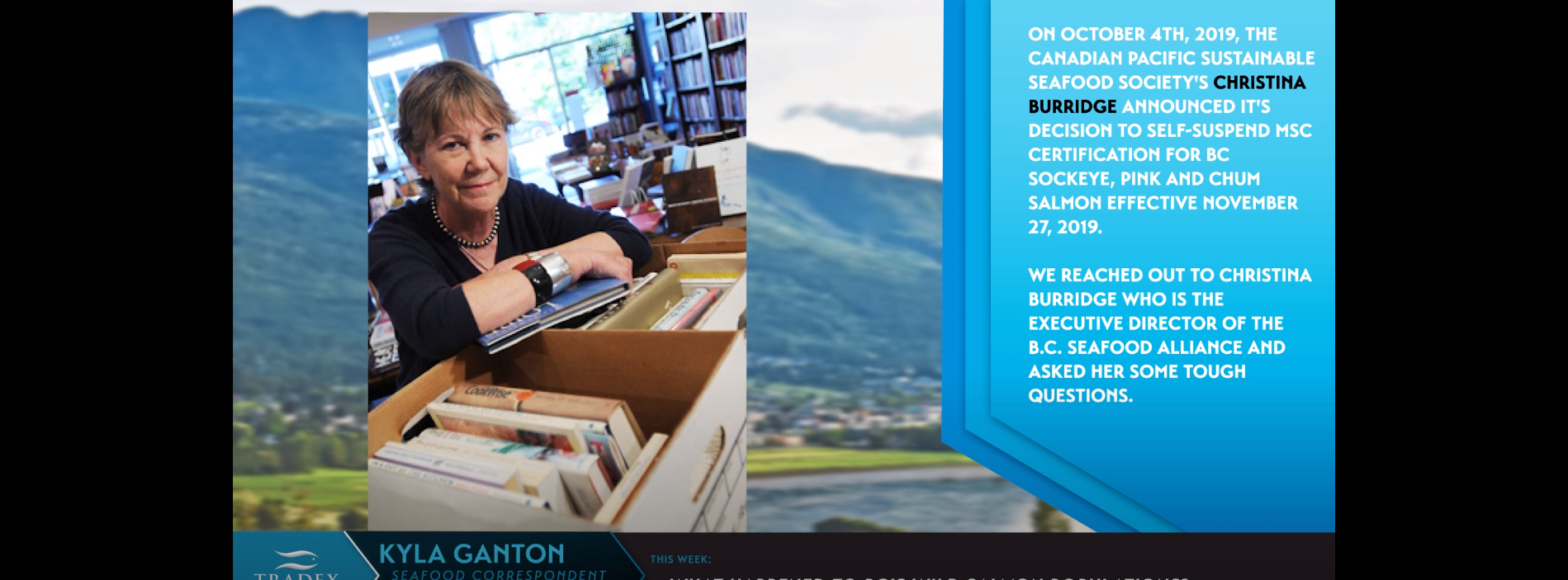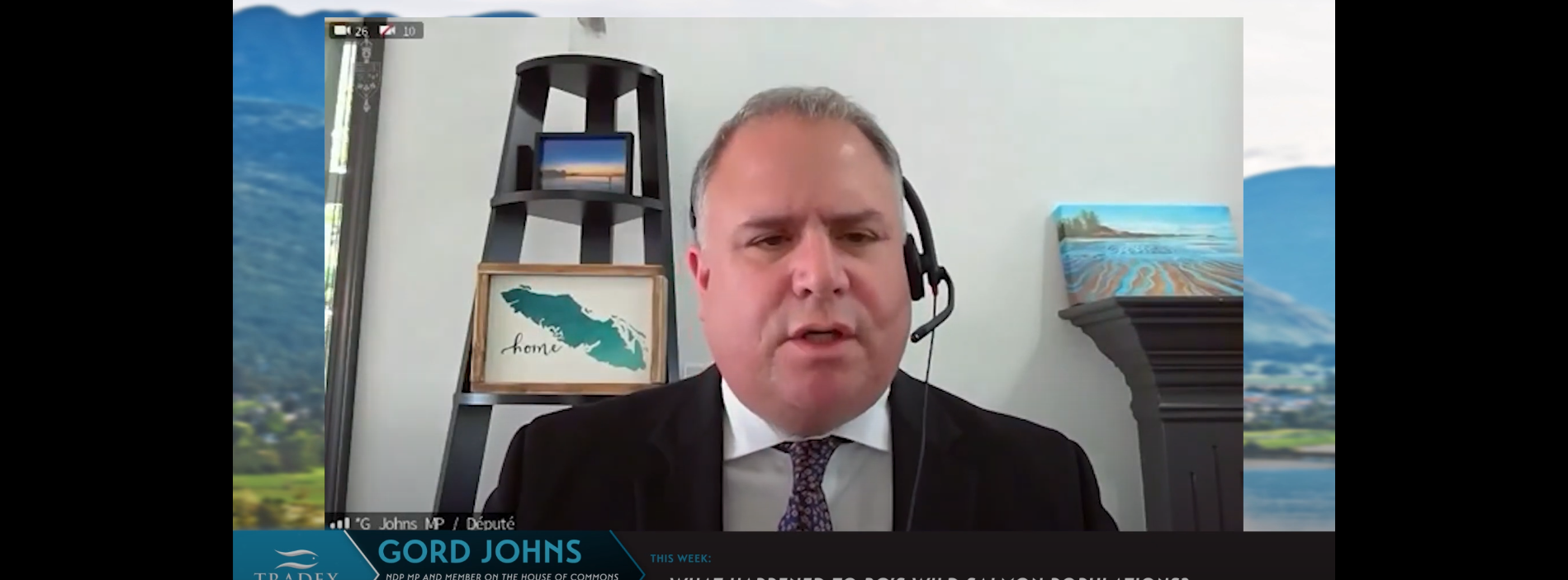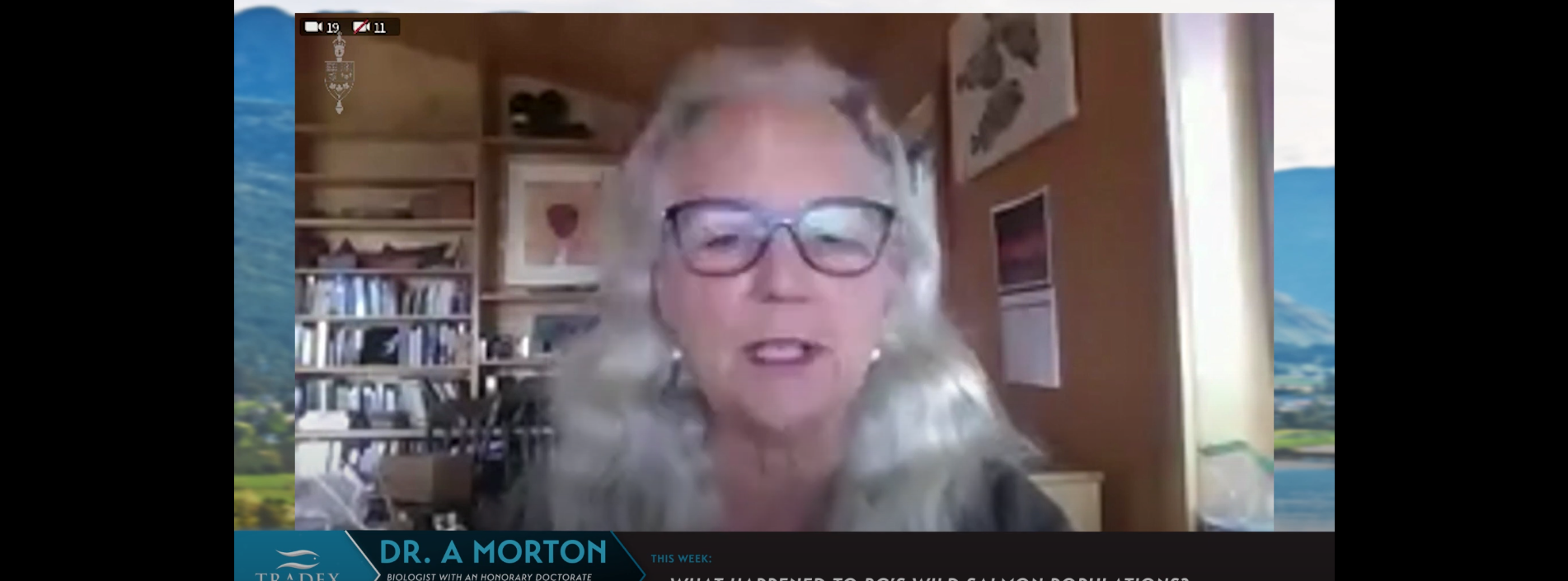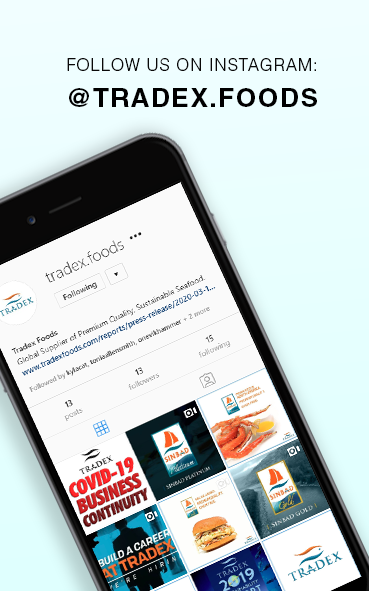
Loading
EP 502 | AIRED 08/24/2020
What Happened to BC's Wild Salmon Populations?
August 24, 2020 --- In this week's report, we investigate What Happened to Wild Salmon Populations in British Columbia Canada as DFO (or Fisheries and Oceans Canada) is presiding over some of the lowest wild Pacific Salmon runs in Canadian history.
--- In this report, we focus on the Suspension of MSC for Sockeye's, Pink's and Chum's, we exhibit the management (or mis-management) of the fisheries by DFO, and we disclose the facts on how open net pen Farmed Salmon on the west coast are affecting Wild Salmon stocks.
Please note that we do recognize there are a number of other factors affecting Wild Salmon populations (such as predation, climate change, ocean migration etc) however we just could not fit everything into one episode so please keep tuned-in for further updates.
--- On October 4th, 2019, the Canadian Pacific Sustainable Seafood Society's Christina Burridge announced it's decision to self-suspend MSC Certification for BC Sockeye, Pink and Chum Salmon effective November 27, 2019.
We reached out to Christina Burridge who is the Executive Director of the B.C. Seafood Alliance and asked her some tough questions.

[Question] Was the self suspension of MSC Certification for BC Chum, Pink, and Sockeye mainly the fault of DFO (not being able to meet target conditions)?
[Christina] We self-suspended because we believed DFO could not demonstrate that the work had been done to show that we could meet the conditions where progress was behind schedule. The MSC assessment team has always been clear that DFO does a decent job of managing BC salmon, given the biological, geographical, cultural and political complexities; it does not do a very good job of documenting its hard work so we struggle to meet the requirements.
[Question] Should DFO ultimately be held accountable for what has happened to BC’s Wild Salmon Fisheries?
[Christina] DFO’s job is to manage no matter what happens to the resource. The assessment says it has done a decent job under changing environmental conditions and ever more complex political and cultural realities. For instance, the commercial harvest rate has dropped from 80 percent in the early 90s when returns were strong to about 20 percent or less today, a level which is unlikely to have much of an effect either way.
Ocean Wise hosted a great webinar summarizing key factors to the self suspension of BC Salmon in which we have provided the transcription below.
[Ocean Wise Seafood: B.C. Salmon Webinar Transcript]
"Previously, before 2017, these species were accessed under 3 different units of certification. It was in 2017 that the first assessment for a combined client group for all three species occurred under the client group “Canadian Pacific Sustainable Seafood Society (CPSSS)”. The fishery was first certified in 2017 and in a number of areas of assessment, the client group (The Fishery) was considered to not to be meeting the MSC unconditional scoring. This therefore triggered the introduction of 22 binding conditions of certification that must be addressed within a specified timeframe. Annual milestones towards completion of these conditions were agreed upon by the client group, MSC and DFO. In 2018, the fishery was due for its first annual audit. The audit was delayed by 6 months to give DFO time to address conditions however they were unable to meet those milestones for that audit. At the time of audit (after that 6 months delay), 22 conditions remained, 11 of which were behind target. Again it is important to note that if these behind target conditions remained in a subsequent audit the fishery would be suspended by MSC. These conditions surrounded a number of factors including DFO’s need to release data to MSC, as well as to plan for a stock assessment for one of it’s management regions. As well a plan was needed to evaluate the effects of hatchery fish on wild populations of Salmon in BC. At this time the fishery client group (Canadian Pacific Sustainable Seafood Society) employed consultants to develop plans to address these conditions. However, currently DFO does not have capacity to implement these plans for 2020 and will be unlikely to be able to implement such plans until 2021 or 2022. As a result, when the fishery client group approached it’s 2019 audit, they felt it would be difficult to pass and unlikely to meet audit milestones for years 3 and 4. It was at that point that the fishery issued a press release of their intended self suspension and the fishery client group voluntarily suspended their certification on November 27th, 2019.
Key Takeaways:
- DFO science is critical to inform management decision making at the federal level for canadian fish stocks. It is also critical to provide up-to-date scientific information allowing for assessment by 3rd party independent organizations like MSC and Ocean Wise.
- At present it appears that DFO does not have the resources required to meet the commitments that are inline with that needed for MSC for this fishery.
- The client group is actively engaging with DFO, MSC, Ocean Wise, and other NGO’s to have this fishery assessed and deemed sustainable as quickly as possible.
- It’s incredibly important to note that this self-suspension is a sign of 3rd party certifications and ratings working." [End Webinar Transcript]

In an interesting turn of events, while we successfully had a preliminary zoom call with Mr Johns (where he genuinely seemed very excited to speak on Wild Salmon Populations), we were then told to submit our questions for a secondary zoom call.
Since submitting the questions and multiple follow up attempts, we received zero response back from the office of Gord Johns - we are extremely disappointed in the lack of communication and participation on this matter.
--- Now moving onto Farmed Salmon and how a virus and sea lice affect Wild Salmon populations.
PRV (or Piscine orthoreovirus) is the causative agent of heart and skeletal muscle inflammation (or HSMI) present in nearly all Open Net Farmed Atlantic Salmon on Canada's west coast.
Wild salmon interests and conservationists have long expressed concerns that PRV emanating from open net Salmon farms could impact wild Salmon passing by.
A March 2019 study undertaken by scientists from the University of British Columbia and DFO's Pacific Biological Station concluded they could not find significant harm to the fish's respiratory physiology despite the virus replicating to a load equal to, if not higher, than those seen naturally in wild or farmed fish. (High-Load Reovirus Infections Do Not Imply Physiological Impairment in Salmon; Zhang et al., 2019)
However, new research may be on the way as we reached out to famed DFO scientist Dr. Kristi Miller-Saunders best known for her discovery of a genomic signature in dwindling Fraser River sockeye salmon populations - but was then muzzled to speak on the research under the Stephen Harper Government.
Kristi advised, "From what is understood, PRV caused diseases occur almost exclusively when water is cool, with marine diseases occurring the first winter at sea, although there have also been incidences of PRV disease in freshwater fry, again in cool months. There is growing evidence from my lab that PRV is capable of causing disease in Chinook salmon, again over their first winter at sea, and this virus does come up as contributing to lower population-level survival when it is prevalent."
--- Sea lice, are marine ectoparasites (or external parasites) that feed on the mucus, epidermal tissue, and blood of host marine fish.
Migrating Salmon pass open net fish farms setup along wild Salmon migration routes infested with sea lice to which they attach themselves onto wild Salmon.
There are numerous published studies spanning over the last decade that conclude louse on juvenile Salmon can drastically reduce their chances of survival.
DFO have established guidelines for acceptable levels of sea lice in fish farms however self-reported data is showing that up to 35 percent of B.C. farms have exceeded these levels.
Results from a recent wild salmon study actually reported that 94 percent of wild Salmon fry in the Discovery Islands had sea lice attached.
-- We now present you with a newly released video of Alexandra's opening remarks in her testimony to the Standing Committee on Fisheries and Oceans during their State of the Pacific Salmon sessions on August 11th.
Alexandra Morton is an Independent Biologist who was granted an honorary Doctorate of Science by Simon Fraser University for her research on sea lice which she began in 2001 - she cites in one of her trials that almost 98 percent of juvenile Pink Salmon with a mature louse died."
[Alexandra Morton] "For the moment, policy is keeping pace with emerging science on an emerging virus. However, this not the case when it comes to salmon runs of national importance. If fishing were the dominant extinction driver for salmon runs, the fact that most salmon fisheries have been increasingly closed over the last few years would have caused the salmon runs to increase. As well, in one of the most heavily farmed regions of the coast, the Broughton Archipelago, wild salmon are declining in the unlogged and logged watersheds.
For some reason, the Canadian government is ignoring critical warnings that salmon farms are harming wild salmon runs. These are coming from the Auditor General's office; Dr. Mona Nemer, the chief science adviser of Canada; and Stephen Harper's Cohen commission, which recommended that salmon farms be prohibited from the Discovery Islands unless Minister Bernadette Jordan can demonstrate, by September 30 of this year, that the risk from the farms is minimal. However, this is not going to be possible for her.
Last fall, then minister of fisheries, Jonathan Wilkinson, announced that the 2019 sockeye return was the lowest in the history of this country; yet on March 1 of this year, DFO granted salmon farms permission to have an unlimited number of sea lice. Predictably, 99% of the young Fraser sockeye on the migration route were infected with sea lice levels that we know will reduce their survival. Wild salmon are simply not making it to sea past the salmon farms.
On July 30, we found out the sockeye trying to go by Port Hardy were infected with an average of 42 lice per fish. These fish are 10 centimetres long, with 42 lice. If this continues, there will be nothing you can do to boost their survival. You have to deal with the salmon farming issue. The sockeye infected with sea lice this year are the dominant cycle. This is the fish the Fraser River nations and commercial fisheries depend on, and we will know the outcome of this infection in 2022.
Then there's the situation with the piscine orthoreovirus, or PRV. One DFO lab says this virus is natural to British Columbia, it's low risk and not to worry about it, but another DFO lab is saying it's a significant risk to Pacific salmon. Academic research is saying that it is not natural to the B.C. coast, as it's from the Atlantic. My research is saying this virus is spreading.
In 2018, Washington state prohibited PRV-infected farmed salmon because they are too big a risk to wild salmon. As a result, the farms in Washington state are standing empty because there are no clean fish for companies to access to put into the pens. Here in B.C., the industry told the Federal Court of Canada that it would be significantly impacted if it was not allowed to farm with PRV-infected salmon, so DFO policy has decided that the virus is natural and low risk. If you don't see a scandal here, it's because you're not looking.
Salmon farms are the greatest single impact on wild salmon since the glaciers, and this impact is entirely removable. The one place on this coast where sea lice are going down is the Broughton Archipelago, where first nations have removed several million farmed Atlantic salmon.
Here are my recommendations to you. You should create a Pacific region director of wild salmon. We need somebody at a senior management level in DFO whose whole life is focusing on restoring wild salmon, and this must be done in partnership with first nations. You should mandate the removal of salmon farms from the ocean, beginning with the biggest migration routes. This would attract significant land-based investment because the infrastructure for this industry is already there.
Also, please harness the remarkable science in DFO that can read the immune system of fish, allowing the fish to talk to us, to tell us where and how we are hurting them, and whether we are making that better or worse. Then the fish themselves will guide their own restoration.
If Canada follows this path, truly meaningful reconciliation begins. We jump right into the fight against climate change by significantly increasing the annual growth in forests and every fishing country in the world will come to Canada to learn how we did this.
Thank you so much for allowing me to be here."

--- When it comes to the management of BC's Salmon Fisheries many people can be quoted saying that "DFO is dropping the ball".
However, rather than dropping the ball, perhaps DFO is trying to juggle too many balls and balance conflicting demands and jurisdictional issues, while trying to develop and implement rational policy.
They hear many messages from different stakeholders, and even different messages from the same stakeholders.
What are your thoughts on the State of Pacific Salmon? We would love to hear from you in the video's comments section.



